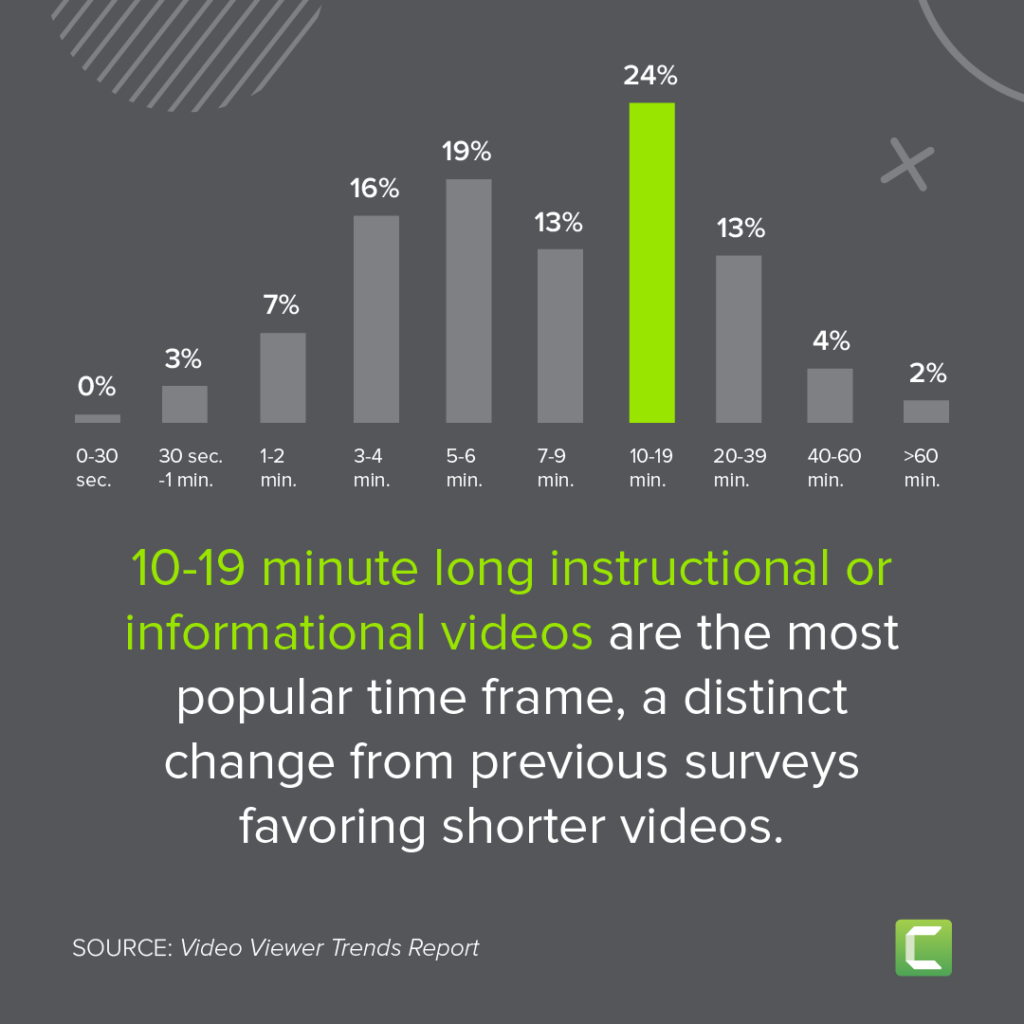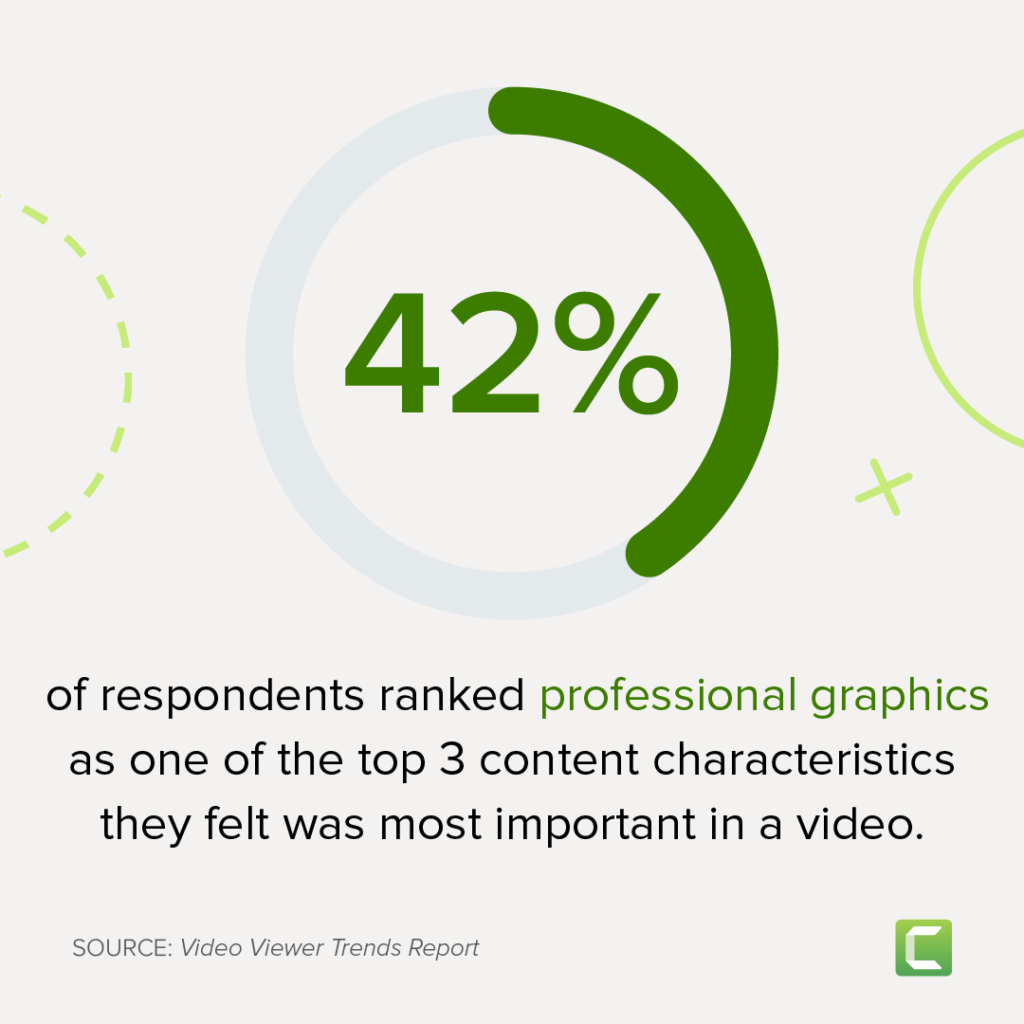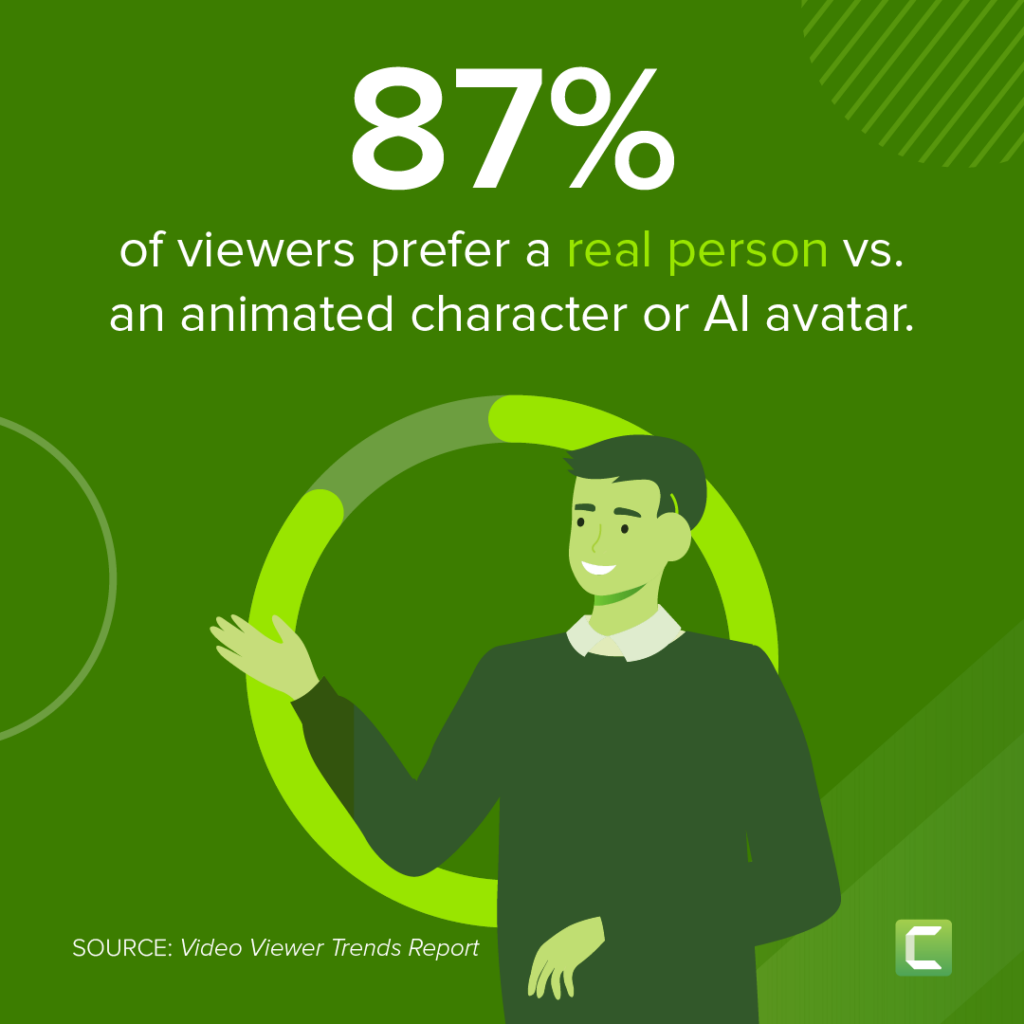Video has revolutionized the delivery of information and training content.
Whether you’re teaching people through online content or training internal coworkers, using video to share knowledge is becoming an expectation.
Don’t make folks spend their time pouring through long, wordy training manuals or documentation to learn a skill, new process, or gain knowledge. In fact, 83% of people prefer watching videos to accessing instructional or informational content via text or audio.
The type of content you create matters just as much as the information you are trying to share, this includes video.
The problem is many companies struggle with how to create and deliver engaging and effective instructional videos that viewers will actually watch.
TechSmith conducted research to learn more about people’s viewing habits and preferences around instructional and informational videos.
We wanted to know: how we can ensure that people start – and continue – watching videos?
– 83% of people prefer to consume instructional or informational content by watching a video.
– People watch videos because they want to. Only 16% of respondents said they watched a video because they had to.
– 87% of viewers prefer a real person vs. an animated character or AI avatar.
– People prefer longer videos than in the past. 10-19 minute long instructional or informational video being the most popular time frame, a distinct change from previous surveys, which showed viewers’ inclination to watch shorter videos.
– Nearly a third of respondents said videos over 20 minutes are too long.
– By using AI tools strategically and selectively, creators can leverage audiences while keeping humanity at the forefront.
– People believe that a quality speaker and audio matters more than conciseness, level of interest, and even clarity.
– 2/3s of those surveyed watch at least one instructional or informational video per week.
People prefer videos
Video has emerged as one of the most powerful and widely used formats for delivering training and instructions, regardless of your intended audience
The acceptance and consumption of video (including mobile video) continue to grow across most departments, segments, and demographics.
This should come as no surprise.
As employees, students, and customers increasingly expect information to be available in video format, businesses are embracing video for its benefits, visual appeal, and effectiveness. In fact, 83% of people prefer watching videos to accessing instructional or informational content via text or audio.
The big question is no longer “Should I create a video?” it’s “How do I create effective videos that people actually watch?”
Learn more in the report
Dive into the insights and advice about 2024 video viewer trends and habits.
Download the Full Report
What types of videos do people watch?
About 50% of the video content accessed by respondents is made up of informal or formal training videos and live streams or webinars.
Respondents could select more than one option, and on average, people chose 2.4 different types of videos, and 71% chose at least two video types. This further suggests that a one-size-fits-all approach to video isn’t ideal. Different videos serve a specific purpose for varying situations and viewers tend to watch a variety of video types.
How (often) do viewers watch videos?
61% of respondents watch videos on YouTube or another public video site.
Putting instructional and informational videos on YouTube is a helpful way to make content available to a broad audience. If you want your videos to succeed, get watched, and reach new audiences, you should pay attention to what about the content draws in viewers.
People aren’t always accessing information through internal resources, and there is a reason for that. Researching the videos watched by your audience and trying to mimic the style and quality can be worthwhile.
Short-form instructional content on social media platforms can also reach a wide audience. 44% of respondents watched tutorials and how-to videos on a social media platform.
Why do people watch videos?
People watch videos because they want to. There is a bigger emphasis on using videos for knowledge and skill acquisition and a lesser focus on using them to solve immediate problems.
The key takeaway here is that YouTube has become one of the world’s leading destinations for informational and instructional content — and that most of that learning is self-directed. People are learning because they want to.
Only 16% of respondents said they watched a video because they had to.
How do people choose which videos to watch? Our data shows that many factors influence their choice.
54% of respondents simply saw a description that matched their needs. That’s a 14% increase since our 2021 study, when under 40% of respondents relied heavily on description. 35% of respondents chose a video because of an interesting or intriguing title, compared to 25% in 2021. In other words, if you want people to watch your videos, make sure they have accurate and engaging titles and descriptions.
Titles and descriptions that get noticed
With titles and descriptions being such an important factor for viewers choosing your video, it’s more important than ever to get them right.
Best Practices
- Attention-grabbing titles are key. You want your video to stand out among the rest so it gets noticed.
- Skip the “how to.” Jump right into the title and drop those two words.
- What can you do for them? Explain what your video can do for them in the description. You’re competing with hundreds of other videos. Why is your video the best option?
- Download the full report for more!
How long should videos be?
We’ve all heard that shorter is better, right? Apparently, wrong!
Respondents shook up preconceptions with 25% preferring a 10-19 minute informational or instructional video respectively.

Combined, 30% and 35% of viewers still preferred either 3-4 minute or 5-6 minute long informational or instructional videos respectively.
These responses are on trend with the vast current consumption of short social media videos and people’s desire to be efficient with their time.
When it comes to required videos, about 60% of respondents prefer short videos, under one minute. This follows the idea that viewers are more likely to spend time on a topic that is directly relevant to their skillset or interest rather than required “homework.”
Viewer’s interest patterns
57% of respondents answered that “it is easy to follow” is the video element that keeps them most interested. Respondents want a comprehensive solution that informs them without being complicated.
Relatable and current content is almost as important with 55% of respondents answering that it keeps them interested in the video.
Content is the most important
The most important quality for a video to have is … content! Of course, viewers want to watch videos that are relevant to their interests or the problem they are trying to solve.
People noticed that a quality presenter and audio as an aspect of the video they found engaging.
Viewers also crave relevant professional-style graphics, style, and lower thirds, which is an interesting pattern given the prevalence of informal training videos.
Stand-out professional graphics.
42% of respondents ranked professional graphics as one of the top three content characteristics they felt was most important in a video.
Graphics aid the viewer by adding information that is beneficial for the viewer.
Visuals that add value
- Lower-thirds add the speaker’s name and, usually, occupation at the bottom of a video clip. This gives viewers insight into who is speaking and their relationship to the material that is being presented.
- Infographics collect key takeaways for the viewer in one convenient space. Make it downloadable so that viewers can save and share the main points with others.
- Download the full report for more!

Why do people stop watching videos?
Videos are meant to be watched all the way through, so what compels viewers to click off prematurely?
For 33% of viewers, they simply got the information they needed before the video ended. After all, that is the aim of most tutorials and once the task is done, the need to keep watching is gone. If people stop watching your videos because they got the information they needed, you should make sure you’re only covering what’s necessary.
22% of respondents reported the video to be boring or uninteresting. We get it. Not all topics are extraordinarily exciting and interesting, but there are a number of ways you can keep your viewers interested. Even just varying the tone of your voice or introducing more motion can make a drab topic seem more exciting.
Lastly, 9% of respondents stopped watching videos because of poor quality. Of those respondents, poor audio and blurry footage were tied for the top spot, followed by insufficient explanation.
What did we learn from this? Be engaging, lively, and concise in your videos.
Don’t be boring
Entertainment value keeps viewers engaged and watching videos. 22% of respondents answered that they stopped watching the most recent instructional or informational video because it was boring or uninteresting.
The top four reasons? Monotone speech, not concise or efficient, video length, and off-topic rants.
Monotone speaker
- Liven up! Viewers are here to learn new information from this content, and they want to be excited about it. Lean into creativity and humor to grasp and retain viewers’ attention.
- Maintain a natural speaking pace and be enthusiastic. Video is information, but it is also entertainment. While it can be tempting for creators to speak slowly to ensure comprehension, giving viewers speed control and speaking at a quicker pace can promote interest.
Efficiency of information
- Get to the point quickly. Introduce important information and requirements right away. Don’t spend too much time on your introduction, telling a story, or giving background information.
- Problems come in many ways and so can solutions. Find the best solution for your audience’s problem and explain it thoroughly but concisely.
Balance video length
- More respondents preferred a 10-19 minute video than a 3-4 minute video. However, longer is not always the key. The majority of respondents would not watch a video 60 minutes and longer. Balance is key here. Ultimately, we always say that your video should be as long as it needs to be.
- Shorter videos are a popular choice, especially on social media, so leverage the platform you’re on. Shorter video lengths may perform better on certain platforms over others, so keep experimenting. Experiment and consider offering shorter as well as long, more in-depth videos on key topics.
Stay on topic
- Create a script and stick to it. You can be intentional with the information included and focus on the problem-solving at hand.
- Be purposeful with what is included. What you find interesting is not what everyone else finds interesting. Small anecdotes that you enjoy but don’t have a specific purpose may detract from your video more than anything.
- If you find yourself trying to cover too much, remember that creating more than one video is an option.
Learn more in the report
Dive into the insights and advice about 2024 video viewer trends and habits.
Download the Full Report
Blurry footage and poor audio quality
Videos with blurry or shaky footage can be unwatchable for some viewers. After all, how are they supposed to learn a new skill or acquire new knowledge if the video can’t show them exactly what they need? To the respondents who stopped watching a video due to poor quality, blurry footage is the biggest deal breaker, tied with poor audio quality.
This is an interesting find as it hints that some types of production quality are valued and expected. Videos need to be, at the very least, put together in a high-quality, understandable way to invite viewers to continue watching.
35% of respondents agreed that high-quality and easy-to-hear audio narration keeps them interested and watching.
On the flip side, fuzzy audio is tied as the top reason respondents stop watching a poor quality video. This means that ensuring that video audio is clear and crisp is key in keeping your audience engaged and interested. Audio needs to be, above all, understandable.
The rise of AI avatars
87% of viewers prefer a real person vs. an animated character or AI avatar. Although viewers are watching videos online, the human connection aspect seems to be inherently important to video creation.
This indicates that picture-in-picture recordings of informational and instructional videos may be here to stay. Viewers prefer to hear and see a real person explain new information to them rather than an AI-generated avatar.

AI’s Helping Hands
75% of respondents indicated that they are very receptive or somewhat receptive to watching instructional or informational video content created with the help of artificial intelligence.
Respondents seem to find a line of demarcation between AI that you can see or hear and AI that simply helps the creator find the content they need.
But AI content does not come without concerns. 90% of respondents have concerns about receiving video content created with AI. Of those concerns, 45% of respondents worry the accuracy of the content may not be up to par.
These concerns, although understandable, can easily be remedied by fact-checking AI content before creating a video. Although respondents seem to be wary about the credibility of AI, you can uphold personal credibility that will shine through content.
By using AI tools strategically and selectively, creators can leverage audiences while keeping humanity at the forefront.
The future of video in the workplace
So much is clear videos are here to stay, but do they have growth potential?
It seems so. Respondents are inclined to make video a bigger part of their workday. 38% of respondents would prefer it if coworkers shared knowledge in the form of more videos. Only 10% of respondents would prefer fewer videos.
Even though only 19% of respondents tried creating an instructional or informational video in the past year, almost half of respondents received screen recording share-outs or content from their coworkers in the past year.
People want videos but are reluctant to make them themselves. We understand – talking to a camera can be uncomfortable – but people are so receptive to them.
The TechSmith Academy has plenty of free resources to create your first tutorial video and screen recording to share with your team. It’s easy to get started, and your coworkers will thank you!
Learn more in the report
Dive into the insights and advice about 2024 video viewer trends and habits.
Download the Full Report
Conclusion
People want to watch instructions and informational videos, that much is clear. Understanding viewer’s preferences and habits around videos provides insight into how to create content that will resonate with an audience. Viewers watching instructional or informational videos want easy-to-follow, relevant content that will help them achieve their goals.
Recently, viewers’ focus has shifted from informal to more polished videos. Plus, although AI can be a helpful tool for content sourcing, viewers are not receptive to its blatant presence, as with AI avatars. Viewers want human-centered content that is engaging, easy to follow, and that meets their needs.



Share